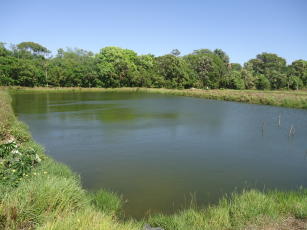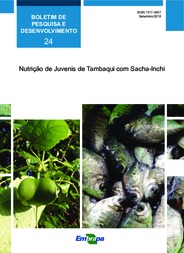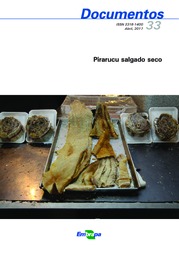Intercontinental consortium to research aquaculture by the Atlantic
Intercontinental consortium to research aquaculture by the Atlantic
Brazilian researchers and the production sector integrate the newly-launched Aquavitae, the largest scientific consortium ever established, to study aquaculture in the Atlantic and within the continents bathed by the ocean. Estimated at eight million euros, mostly from the European Union program Horizon 2020, the project gathers 29 institutions from 16 American, African and European countries with the aim of increasing aquacultural production through research to be developed in the next four years.
“This will be achieved especially through the development of new species of a low trophic level (in the food chain), which are at the base of the energy pyramid, such as seaweed and mollusks, for example", explains the researcher from Embrapa Fishery and Aquaculture (Palmas, TO) Lucas Torati, one of Aquavitae's coordinators in Brazil. With this, the scientists intend to work in systems in which waste at each trophic level are reduced using residue from the other.
"For instance, if we put in the same production system a carnivorous fish with another filter feeder, the leftover feed the carnivore leaves behind will become a nutrient for the seaweed, which in turn will be consumed by the filtering fish. A different production system known as multitrophic", Torati illustrates.
Fruit of ten years of joint workThe head of Research and Development of Embrapa Fishery and Aquaculture, Eric Arthur Routledge, considers the international consortium a valuable achievement. "It is the fruit of ten years of liaison that involved the Brazilian Ministry of Science, Technology, Innovations and Communications (MICTI) with the participation of Embrapa and some Brazilian universities that are references in aquaculture", he underscores. Routledge reports that such intermediation informed the Brazilian government and the European Community's formalization of the agreement for Atlantic research and innovation cooperation, the “Belém Statement”, signed by Brazil, South Africa and European Union, in July 2017. It enabled the first participation of Brazil in the international consortium that approved, at the end of 2018, the Aquavitae project, whose first meeting, which marked the beginning of the activities, took place in early June this year, in Norway. |
In Brazil, the main studies will involve the production of pirarucu (Arapaima gigas), tambaqui (Colossoma macropomum) and shrimp (Litopenaeus vannamei), as well as other species of interest for the country, like oysters and macroalgae. Besides Embrapa Fishery and Aquaculture, Embrapa Mid-North (Teresina, PI), Embrapa Western Amazon (Manaus, AM) and Embrapa Coastal Tablelands (Aracaju, SE) will participate in the activities. Other participating educational institutions that are recognized for their aquacultural research include the Federal University of Santa Catarina (UFSC), the Federal University of Rio Grande (FURG) and São Paulo State University (Unesp).
Embrapa intends to improve pirarucu reproduction protocols, in partnership with Unesp and Nofima, the Norwegian institute of research in aquaculture and food that will coordinate Aquavitae. The Brazilian scientists also want to contribute to the development of public policy and governance in aquaculture, study the development of tambaqui and pirarucu production protocols, and survey on the value chain for such two fish.
"In pirarucu's case, we will perform a study to try to better control reproduction using hormonal and environmental stimuli. It is an ambitious and necessary work that will use all the existing knowledge and technologies in the area", Torati details.
Strong partnership with the production sector
One of Aquavitae's main characteristics is the expressive participation of the production sector in all the countries where the project will be executed. In Brazil, there are seven partners of the industry, such as Primar Aquacultura, the first certified organic aquacultural farm in Brazil, and the Brazilian Association of Fish Farming (Peixe BR). "The research is conducted in line with the demands of the production sector", Torati asserts.
In addition to case studies - focused on a species, process or product - Aquavitae will also involve "Work Packages", which are cross-cutting subjects that encompass several case studies. All in all, the project nests 11 case studies and nine work packages.
"Within the work packages there is research on the use of sensors, data integration, Internet of Things, food security, nutrition, environmental monitoring, sustainability, socioeconomic analyses, governance and policy in aquaculture, among others", Torati lists. The institutions that are going to work on the case studies have industrial partners.
Aquaculture that mimics natureIMTA or Integrated Multi Trophic Aquaculture (Aquicultura Integrada Multitrófica) consists in integrating organisms of different trophic levels so that there the nutrients of the environment are better exploited, in accordance with the precepts of circular economy, bioeconomy and biomimetism, the study for the imitation of nature. This system promotes nutrient recycling in the same production unit, which can be either the fishery or the farm, potentializing the generation of ecosystem services. |
Larger tambaqui
The fish of Brazilian origin that is most cultivated in the country has a lot to grow in production and size. This is what the Embrapa Western Amazon researcher Fernanda Almeida, believes. She was one of those responsible for identifying the stage when the sexual differentiation of the fish takes place.
This discovery should contribute to the development of technologies that will boost production. "The fish is likely to present larger size and weight than the current tambaqui's", the scientist anticipates.
She explains that Aquavitae will also use genetic engineering to establish efficient protocols in tambaqui production and improve important production indicators such as growth and meat quality.
Production systems for the species in excavated fisheries and in dikes also need to be improved, according to the specialist. Despite performing well in intensive production systems, tambaqui is continuously exposed to some stress factors, such as changes in the water chemistry, high stocking densities, excessive handling and indiscriminate use of drugs to treat diseases. "Studies are necessary to further improve breeding and cause less impact on the environment", the researcher recommends.
Shrimp, oysters and seaweed in the same space
An intensive high-yield breeding system that allows the use of lower amounts of water, requires less time and offers lower food conversion. That is Bioflocos, a system that Brazilian researchers will develop for the cultivation of shrimp, macroalgae and oysters in the scope of "Case Study 5: Biofloco in multitrophic integrated system and integrated multitrophic system in fisheries", a partnership between UFSC, Unesp and Embrapa Mid-North.
"However, there are some technological bottlenecks throughout the project that hinder the industrial-scale application of the technology in Brazil", states the Embrapa researcher Janaína Kimpara, informing that UFSC will be the one responsible for this challenge and that the Embrapa and Unesp teams will work in the design of an integrated shrimp production system with organisms at a low trophic level, such as macroalgae and oysters, in partnership with the company Primar Aquicultura.
The scientist reports that the shrimp, which are carnivorous, feed from benthic organisms in the fisheries; the macroalgae are autotrophic and assimilate dissolved inorganic nutrients; while the oysters, filter feeders, nourish themselves from organic particles in the water column. "Thus, a single space results in three different products, which, besides the above-mentioned ecological gains, allows for greater diversification of products and markets for the farmer, and increased farm resilience", the researcher underscores.
The project also established there will be studies to reduce environmental impacts, reducing the emission of effluents or destining them to other applications so that they are not launched into the environment. Kimpara explains that the leftovers not consumed by the shrimp are assimilated by microorganisms and generate some compounds that are usually launched into the natural environment. "Such compounds can be used as inputs for other aquacultural activities in integrated multitrophic systems", she asserts.
Insertion in the macroalgae market
One of the foci of the project is the study of the technical-economic viability of cultivating macroalgae and the proposal of business-oriented models to explore the activity on sustainable bases.
The technical viability of producing algae in shrimp systems will be assessed. "We will estimate the sustainability of the cultivations by using multicriterial indicators in the economic, social and environmental dimensions. In parallel, a study on the market for the trade of macroseaweed products for food and cosmetics", informs the researcher.
After this study, business models will be elaborated to inform the development of macroalgae production in Brazil for the food and cosmetic markets.

Macroalgae in the world
Marine macroalgae are used in the whole world in an enormous range of applications, either to be consumed fresh or in products from the food, cosmetic, ink and other industries.
According to the last report by the Food and Agriculture Organization of the United Nations (FAO), 27.300 tons of marine macroalgae were produced in the world in 2014. This corresponds to more than 50% of the world's total aquacultural production.
In 2014, Brazil imported US$ 8.77 million in macroalgae products from China (63%), Phillipines (17%) and Indonesia (11%), according to the latest data from the Observatory of Economic Complexity.
The global values of industrially processed macroalgae have been estimated at a billion dollars and the demand for such products has grown about 10% a year.
Photo: Janaina Kimpara
Oysters in warmer waters
One of Aquavitae's main goals in Brazil is to promote technological advances to expand the cultivation of oysters of the native species Crassostrea gasar in hotter regions, such as the North and Northeastern coast. This expansion is directly related to the domestication of the species and advances in its technological foundations, explains the researcher Jefferson Legat, from Embrapa Coastal Tablelands.
The scientist informs that 90% of the oysters cultivated in the country come from the cold waters of Santa Catarina, where there is a prevalence of the cultivation and consumption of the Pacific oyster Crassostrea gigas, whose production is restricted to environments with lower temperatures. "Hotter waters compromise the growth and survival rates of this species", Legat details.
"The production of oysters in the North and Northeast is limited by the difficulties in correctly separating native oysters species for cultivation, in regularly obtaining seeds to supply breeding and fattening, and in adjusting the best fattening system for the different regions of the country", reports the scientist, who will work with Alitiene Pereira and Ângela Legat, a other Embrapa researchers.
Aquavitae will join efforts with other ongoing projects that deal with the same topic, like: "Technological bases for the sustainable production of native oysters in the North and Northeast (OstraNNE)" and "Aquiculture with Technology and Sustainability (Aquitech)".
Translation: Mariana Medeiros
Elisângela Santos (MTb 19.500/RJ)
Embrapa Fishery and Aquaculture
Press inquiries
pesca-e-aquicultura.imprensa@embrapa.br
Phone number: +55 63 3229-7834
Maria José Ferreira Tupinambá (MTb 114/AM)
Embrapa Western Amazon
Eugênia Ribeiro (MTb 1091/PI)
Embrapa Mid-North
Saulo Coelho Nunes (MTb 1.065/SE)
Embrapa Coastal Tablelands
Further information on the topic
Citizen Attention Service (SAC)
www.embrapa.br/contact-us/sac/




